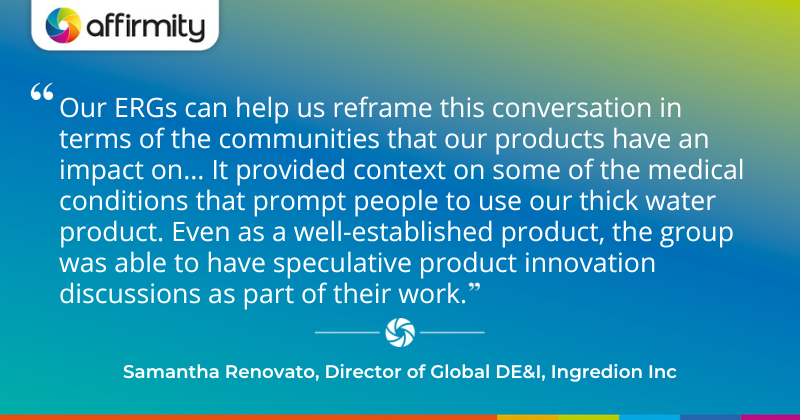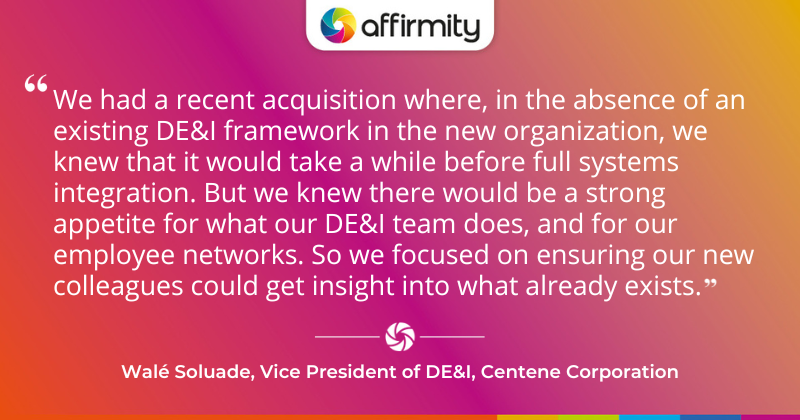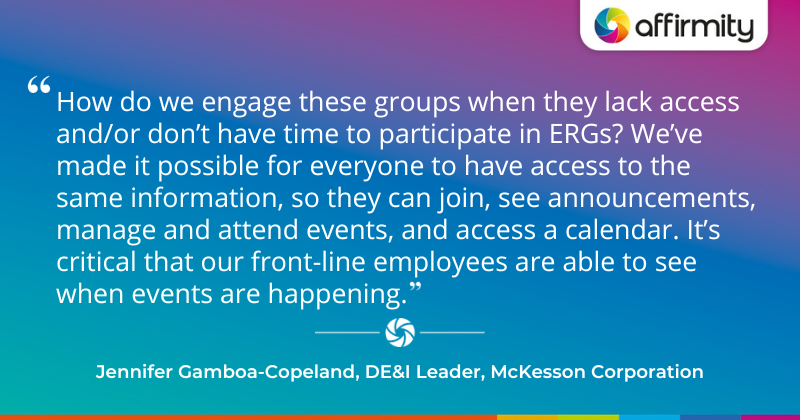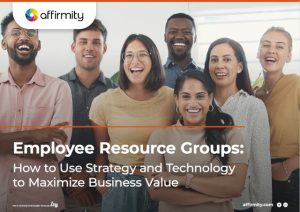Employee Resource Groups (ERGs) can open up significant networking and awareness-raising opportunities for your people, while acting as a powerful strategic tool for your business. We recently held a lively discussion with several DE&I leaders from a range of global corporate businesses—all ERG platform users—to shine a light on these strategic possibilities.
Read on to discover three ways their ERGs are helping them create better business outcomes.
1) ERGs Help Organizations Better Understand and Improve Their Product Offering

Ingredion Inc’s Director of Global DE&I, Samantha Renovato, shares her experiences with how ERGs can be used to eliminate gaps in business and product knowledge. Ingredion is a producer of starches, sweeteners, proteins, and other ingredients used in the food, beverage, and pharmaceutical industries. Like many global companies with large product portfolios, it can be difficult for employees to understand everything that Ingredion does.
Renovato explains: “Our ERGs can help us reframe this conversation in terms of the communities that our products have an impact on.” Ingredion has nine ERGs (though the term “BRG” is used in company literature). Renovato points to an example from its “Empowered” ERG, which has the goal “Empower Employees with Disabilities”:
“The Empowered ERG partnered with some of our business leaders to improve organizational knowledge about one of the starches we manufacture. This starch adds texture to a product called ‘thick water’ which helps people with dysphagia (the medical term for anyone experiencing difficulty swallowing) to stay hydrated.”
“The ERG was able to provide context on some of the medical conditions that prompt people to use thick water, as well as a general overview of the history of its use. Even as a well-established product, the group was able to have speculative product innovation discussions as part of their work.”
“The starch is currently available as a stir-in powder or as a pre-bottled solution, but the session saw a couple of ideas around how we could package the product differently with the view of improving the everyday experience of anyone who needs it. For example, what does it look like when someone with dysphagia goes to a restaurant? Are there more portable formats that would make this experience easier?”
“We’re primarily a business-to-business organization, rather than a consumer-facing one, so this kind of work is important in deepening our relationship with the wider community.”
FIND FURTHER STRATEGIC THINKING | ‘An Introduction to the 4 Key Strategies Every DE&I Program Needs’
2) ERGs Are Indispensable During Mergers and Acquisitions

Walé Soluade is Vice President of DE&I at Centene Corporation. Centene is a global healthcare services company with its sights set on geographic expansion, product, and membership growth. As a consequence, it’s often in acquisition mode.
Soluade notes that when acquisitions happen, Centene’s ERGs (EIGs in company literature) give it “the opportunity to hit the ground running from a culture standpoint.” He expands on this by observing:
“We’re able to say: this is who we are, these are the things we do to engage with one another. Because our groups are employee-driven and employee-led, this is seen as less of a corporate thing. We get to build new relationships, and that’s something we’ve tried and driven home. The point of a lot of our work is to deepen interpersonal relationships and find how we work better together.”
Soluade also touches on how ERGs can help work towards culture goals before full systems integration is available:
“We had a recent acquisition where, in the absence of an existing DE&I framework in the new organization, we knew that it would take a while before full systems integration. But we knew there would be a strong appetite for what our DE&I team does, and for our employee networks. So we focused on getting the ball rolling so that our new colleagues could get insight into what already exists.”
“It has always been rewarding to see everything kick in, and to start seeing the passion build with folks as they start to tap into our personal and professional development tools within the groups. Even the networking stuff alone can be a really powerful way for organizations to show who they are as they go through acquisitions and seek to build consistency across employee experiences.”
LEARN MORE ON THIS TOPIC | ‘6 Ways to Leverage Mergers and Acquisitions to Build Better Inclusion’
3) ERGs Help Organizations Reach Their Extended Workforces

Jennifer Gamboa-Copeland is DE&I Leader at McKesson Corporation, a pharmaceutical logistics, technology, and services company. She observes that many ERGs start internally with the exempt employee populations (or essentially your employees with email addresses), but that McKesson’s ERGs needed to address a much wider audience—distribution center staff, drivers, and call center workers.
Gamboa-Copeland remarks that this “presents a significant challenge: how do we engage these groups when they lack access and/or don’t have time to participate in ERGs?” McKesson’s solution included the development of an ERG mobile app—connected directly to our ERG platform—making information available via employees’ personal devices.
“We’ve made it possible for everyone to have access to the same (or, at least, similar) information, so they can join, see announcements, manage and attend events, and access a calendar. Calendar access is obviously very important in an ERG context, and it’s critical that our front-line employees are able to see when events are happening.”
“We’ve also acknowledged the need to ensure that the mentoring element of the ERG platform is available beyond our “wired” employees, and are in a pilot process for extending it to our “non-wired” population in our distribution and call centers.”
McKesson actively promotes its ERGs to ensure they can be rolled out to as many staff as possible:
“We’ve created a microsite on our internal website and set up tables at our distribution centers, both operating in multiple languages to help us get the word out. Frontline leaders are able to access the information, download and print one-pagers with QR codes, and distribute those to their reports.”
“We want to make it really simple and easy to access the platform and to access our groups. It isn’t ‘solved’ by any means—but as an ERG operations team, we’re here to help continue to educate and help as many people benefit as possible.”
Samantha Renovato describes similar group accessibility efforts at Ingredion:
“In addition to the technology, we have inclusion leads in place for most of our ERGs. Where we don’t, we’re actively promoting the groups through certain affinity months and events, with plenty of free swag to hand out. Where employees don’t have visibility on the ERGs, this swag helps get the word out, and our efforts help to get people interested in starting new chapters.”
“It’s important to be proactive and to use these events and our inclusion leads to raise awareness. We also have to think about accessibility: from our side, it often makes sense to have a lunch-and-learn session. However, for some of our employee groups, especially those in plants or manufacturing facilities, it may make more sense to schedule things around their 2pm shift change.”
Walé Soluade notes that Centene has also had to think intelligently about employee schedules in order to maximize ERG participation:
“A lot of the work in our claim centers is very time-specific, so we bring in our workforce management people, our teams responsible for our people’s shift scheduling, to help us create the space for people to participate in things. We recognize that not everyone’s going to be able to take an hour away from the phone or the computer, but we can try methods such as demand-based scheduling that make participation possible.”
“Conversations with leaders have also been key, helping them understand their role in helping to prevent employees feeling like they don’t have time or are unable to attend. By taking everything: the microlearning, the intentional communications pieces, and then creating the space for people to consume what’s being built, we’re making sure that leaders understand that this is as much a priority for the organization as any other business activity within our company.”
DISCOVER MORE FROM OUR BLOG | ‘3 Ways to Have Intersectionality Signpost the Road to Equity’
Continue Reading: Discover How ERGs and ERG Software Drive Real Business Value
The conversations in this blog post are extracts from our ebook, ‘Employee Resource Groups: How to Use Strategy and Technology to Maximize Business Value’. Check out the full ebook for further real-world examples and see how ERGs—when supported by the right technology—can be applied to strategic problems organizations like those yours face every day. Additional topics include:
- The groundwork needed for ERGs and ERG technology to thrive
- How technology can be leveraged to measure ERG ROI
- Thoughts on effective ERG budgeting
- Where ERG leaders are focusing their efforts for the near future

For more information about our ERG platform, please visit our website, download the product sheet or contact us for more information.
 About the Author
About the Author
Maneet Sarai is the Chief Product and Revenue Officer at Teleskope. Teleskope is a leading software solution provider in the DE&I space and caters to the growing needs of many Fortune 500 companies. Teleskope’s product suite includes ERG management solutions, mentoring and talent development solutions as well as organizational communication tools. Affirmity’s ERG platform is powered by Teleskope. Maneet is a tech enthusiast and has moderated multiple webinar panels for Affirmity.
